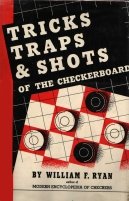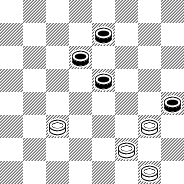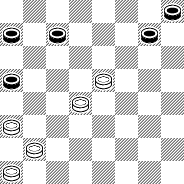The Checker Maven
Jump to navigationTwo Easy Pieces

This excellent book of tactics is extremely difficult to find at any price. Yet, it is such a valuable reference and training book for beginner and intermediate alike, that The Checker Maven has decided to produce, over a period of months, a freely available electronic version. (Recall that we did the same with Arthur Reisman's fine book of basics, Checkers the Easy Way, available in Postscript and PDF formats.) The copyright is long expired, and there are no legal or ethical barriers to republication.
We'll present a few pages in The Maven every few weeks, as mood and opportunity catches us; and we'll simultaneously gather it all together in what will eventually become a newly-typeset printable book.
Let's start off, then, with a pair of problems from the introductory pages of the book. We've called them Two Easy Pieces, and though these are speed-solvers for the experienced player, they present important basic concepts for the learner to master. Willie's own entertaining commentary accompanies each problem.

White to Play and Win

White to Play and Win
When you've given these a good try, click on Read More for the solutions.
Solutions
Example 1 27-23, 20-27, 23-18, 27-31, 18-2, 10-14, 2-6, 31-26, 6-9, and white wins.
Example 2 21-17, 13-22, 15-10, 6-15, 18-11, 8-15, 25-11, 5-9, 29-25, 9-14, 25-22, and white wins.
Comments received from John:
Also, regarding the ethical dimensions of copying TTS, note that little, if any, of this book contains material original with Ryan. I don't recall at the moment if he claims originality for any of the settings, but most are recycled from much older texts.
John also noted that he has PDN available for the games in the book; we've linked his site as "John's PDN" in the left column of the Front Page. --Ed.
You can email the Webmaster with comments on this article.
